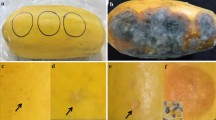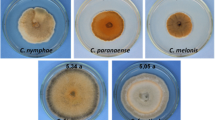Abstract
Botrytis spot or ghost spot on tomato fruits occurs after penetration of germ tubes ofB. cinerea into epidermal cells. A few days after the penetration a halo appears around the infected necrotic cells. These symptoms can be reproduced by inoculating young fruits with a few dry conidia. When many conidia alight on the epidermis of the fruit, scab-like symptoms develop, while under conditions of high humidity, blisters can be formed on the fruit surface before the fungus spreads through the fruit parenchyma. Under conditions of low humidity, necrotic areas are formed.
In the necrotic cells, developed after inoculation with many or with a few conidia, no mycelium could be found by the histological methods so far used. However,B. cinera can be reisolated, implying that theBotrytis spot is a latent infection by the fungus. No renewed growth takes place when the fruit is fully ripe.
Samenvatting
Botrytis-stip op tomatevruchten ontstaat na binnendringen van kiembuizen vanB. cinerea in epidermiscellen van een jonge vrucht. Enkele dagen na de infectie treden celdelingen op in het onderliggende parenchymweefsel. De geïnfecteerde cel en enkele aangrenzende cellen sterven af, terwijl rondom dit necrotische plekje een zilverwit gekleurde ring ontstaat. Worden veel conidiën bijeen op een vruchtwand gebracht, dan krijgt de epidermis binnen 24 uur een schurftig uiterlijk. Blijft de luchtvochtigheid na de inoculatie hoog, dan kunnen daarentegen kleinere en grotere blaasjes in de vruchtwand ontstaan. Deze barsten na enkele dagen open, terwojl mycelium zich door de vrucht verbreidt. Daalt de luchtvochtigheid circa 16 uur na de inoculatie, dan blijft de aantasting beperkt tot de epidermis. Hoewel in het necrotische weefsel geen mycelium vanB. cinerea kon worden aangetoond, blijkt herisolatie van de schimmel gemakkelijk te zijn. Ook uitBotrytis-stippen van uit de praktijk afkomstige vruchten kanB. cinerea geïsoleerd worden. Dit betekent, dat het hier om een latente infectie gaat, waarbij evenwel geen hernieuwde groei plaats vindt als de vrucht geheel rijp is.
Similar content being viewed by others
References
Anisworth, G. C. & Oyler, E., 1938. The spotting of tomato fruits by Botrytis. Rep. Cheshunt hort. exp. stn. 1937: 46–48.
Ainsworth, G. C., Oyler, E., & Read, W. H., 1938. Observations on the spotting of tomato fruits by Botrytis cinerea Pers. Ann. appl. Biol. 25: 308–320.
Ferrer, J. B. & Owen, J. H., 1959. Botrytis cinerea the cause of ghost-spot disease of tomato. Phytopathology 49: 411–417.
Lepik, E., 1928. Differential staining of Peronosporaceae. Phytopathology 18: 869–872.
Read, W. H., 1937. Water spot of tomato fruits. Rep. Cheshunt hort. exp. Stn 1936: 64–69.
Wilson, H. M., 1966. Conidia of Botrytis cinerea: Labeling by fluorescent vital staining. Science, N.Y. 151: 212.
Winsor, G. W., 1966. Some factors affecting the composition, flavour and firmness of tomatoes. Scient. Hort 18: 27–35.
Author information
Authors and Affiliations
Rights and permissions
About this article
Cite this article
Verhoeff, K. Spotting of tomato fruits caused by Botrytis cinerea. Netherlands Journal of Plant Pathology 76, 219–226 (1970). https://doi.org/10.1007/BF01974334
Accepted:
Issue Date:
DOI: https://doi.org/10.1007/BF01974334




